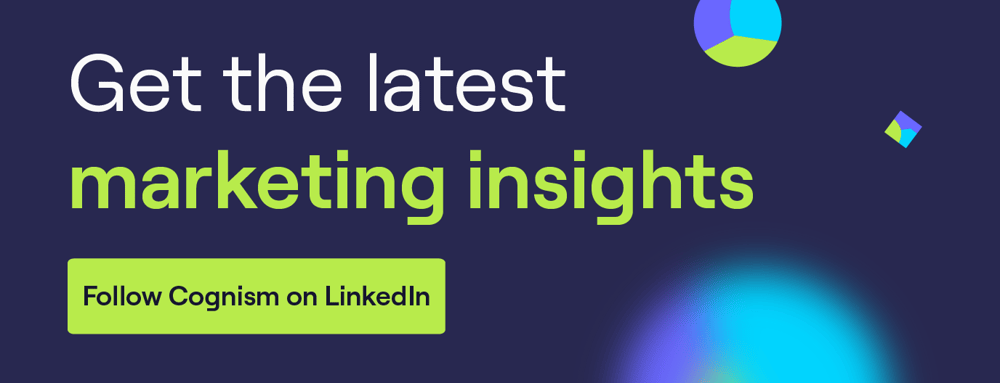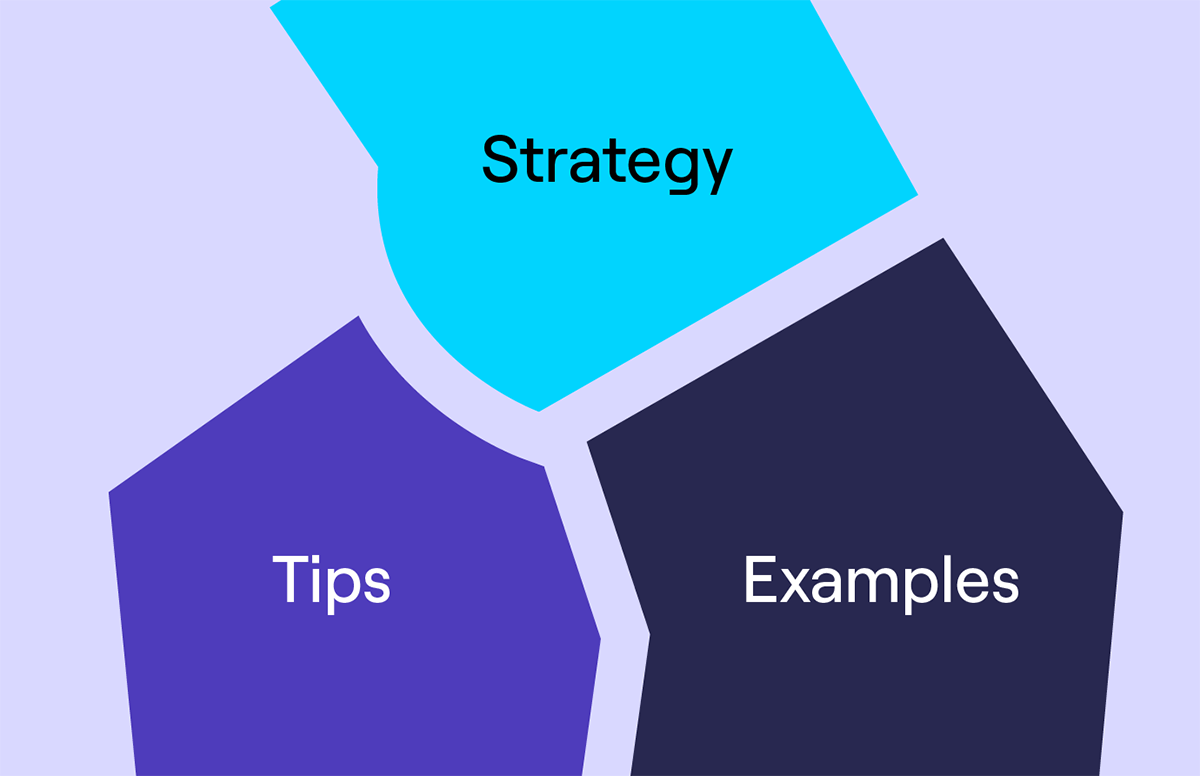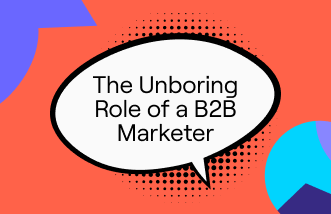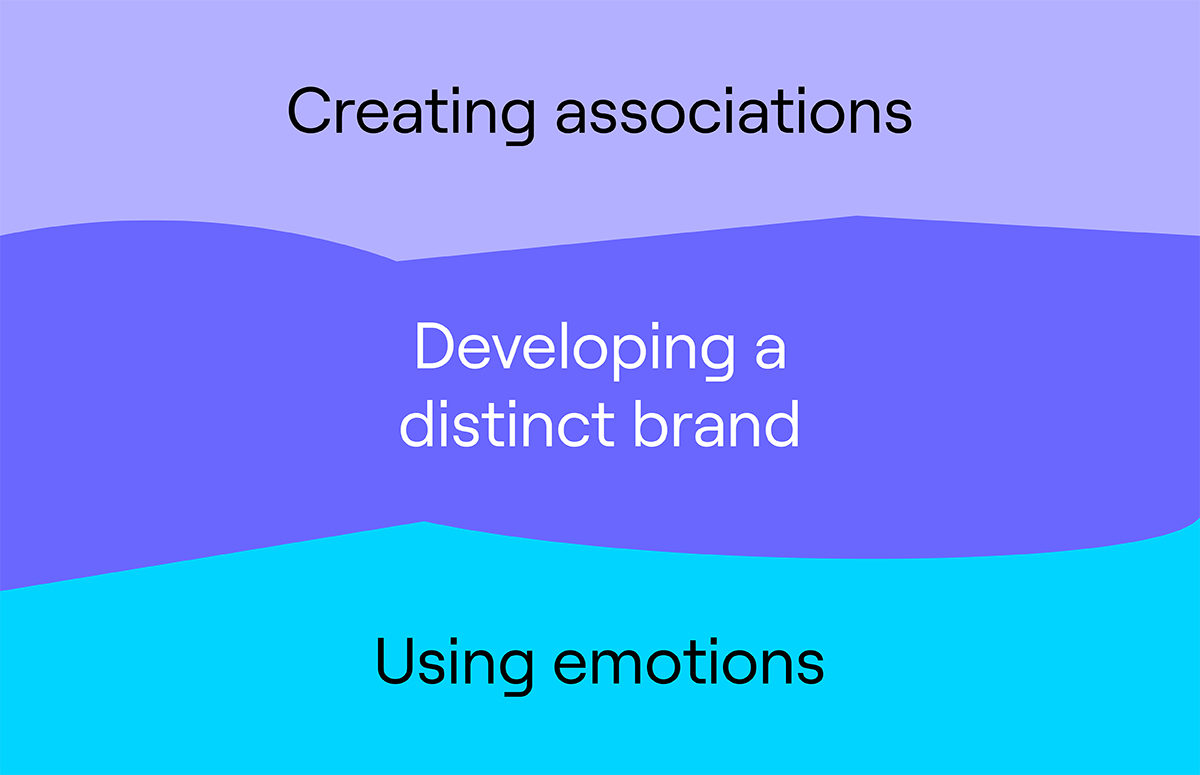B2B Marketing: Art Vs Science
Once upon a time, marketing was an art form.
Think large, flashy typography and campaigns that popped right off the page, sticking with you for years to come.
This was before digital marketing became a concept and big data revolutionised the entire industry.
Now marketing has become more of a science. Practically everything can be tracked and optimised, from email marketing, SEO, social media, paid ads and revenue.
But, the B2B marketing world is split:
On the one hand, we have those who agree that marketing is an art form, and on the other, those that believe marketing should be science-led.
But, as David Cacik, CMO at CloudTalk.io says:
“Marketing is a broad term that includes many different techniques, some of which are science and some that are art. The two areas often overlap, but there are definite distinctions between them.”
“Marketing can be thought of as an art when it comes to the creative side such as advertising campaigns or social media marketing. However, when it comes to things like customer service or pricing strategy (which have more data-driven aspects), then marketing becomes more of a science.”
We want to end the debate once and for all - so we’re looking into why mixing science and art in your marketing campaigns is pivotal to your success.
Scroll 👇 to start!
The art of marketing
Aesthetically, art can be anything to anyone, but to B2B marketers, it holds more of an extrinsic value.
Why?
Because we're relying on our audience to buy what we're selling, and to do that, we need to connect with them on a deeper level.
In fact, 47% of B2B buyers will read three to five pieces of your content before making a buying decision.
This is why we need to create exceptional content that stands out.
Which makes marketing art...
Doesn't it?
According to the definition of art, marketing is, in fact, an art form:
“The expression or application of human creative skill and imagination, typically in a visual form.”
It goes without saying that we can't create a successful marketing campaign without some form of creativity.
Imagine how boring it would be if we gave our audience a form of advertising based only on metrics?
It would come off as robotic with no human connection whatsoever.
And as humans, we need to create a connection, which is why art is such a powerful marketing mechanism.
Making a connection
How does the art of marketing help you form a deeper connection with your prospects and customers?
To answer this question, think about the last campaign you witnessed that's stayed with you long after.
What made it so memorable?
It certainly wasn't data, was it?
While data can help reveal your buyer's needs, artistry is behind crafting campaigns into things your audience can engage with on an emotional level.
Francis Angelo Reyes, Founder of Lupage Digital says:
“Marketing is an art because it requires empathy. You need to bring innovative ideas on how to communicate your messaging to your users. You need to engage your buyers with a story on how your business can solve their problems.”
“Marketing pertains to the design of your advertisement and the design of the user experience. This is because marketing doesn't stop at advertising. The way people interact with your product matters too.”
Marketers who embrace their creativity can weld the very core of what makes us human into their campaigns. Whether it's desire, fear or an innate longing, they know how to transform feelings into something tangible that engages an audience.
This understanding of human behaviour is what makes a campaign authentic.
This is what drives people to want to start talking with your brand, and those conversations, in turn, build meaningful relationships with your buyers.
And, believe it or not, if your buyer emotionally connects with your brand, they're 50% more likely to make a purchase.
Creativity isn’t always measurable
What would B2B marketers be without metrics?
It goes without saying that metrics are needed to optimise campaigns, but the artistic elements of marketing often can't be measured.
And, just because something isn’t measurable doesn’t mean it’s not effective. Or as Chris Walker, CEO of Refine Labs, likes to say:
“When you strive to measure things, you often do things that aren't the best things to do.”
Like overlooking creativity in your campaigns and relying too much on metrics.
Back before digital, marketing wasn't as measurable. Instead, we survived on instinct, and it worked. Some of the most outstanding marketers of all time have come from an age where marketing relied more on art than science.
But how does creativity serve to generate leads?
Firstly, it creates brand awareness.
Imagine seeing a bunch of campaigns you like with all different designs, colours and logos. Apart from the company name, would you suspect they’re all from one company?
Creativity makes you recognisable. It helps drive customers to your door, and if those customers can't recognise your brand, they might just mistake you for someone else.
That, or they might forget about you entirely.
Secondly, creativity is what makes a prospect stop and go, 'Wow, now that's a product or service I want to invest in.'
This can primarily come down to organic marketing, but human intuition is irreplaceable at the end of the day. So if you want to target humans, you need that H2H element in your marketing.
With this said, it’s important we don’t forget that there will always be challenges that can only be solved with the power of human creativity or, as Andrea Bosoni, the Founder of Zero to Marketing, puts it:
“Marketing has always been more of an art than a science. Lately, this is becoming even more evident. Take online advertising, for example. All major platforms are leveraging AI and machine learning to give advertisers a set it and forget it experience.”
“Everything is becoming automated. Advertisers don't need to worry about technical aspects like bidding or targeting anymore, so they can focus more on the creative. In this new world, creativity is what really makes the difference. And there's no scientific method to replicate creativity that resonates with your audience.”
The science of marketing
There's been a dramatic shift towards science-based marketing ever since digital marketing joined the mix.
Which hasn't necessarily been a bad thing.
Science-based marketing is logical. As B2B marketers, we’re able to look at the facts in the form of data and deeply analyse those figures for better results next time.
It's a far cry from how we used to do marketing; it’s also made for an even more competitive market. However, the truth is in the metrics, and 64% of marketing executives believe data-driven marketing has been crucial to their success.
But can we really say marketing is influenced by science?
The definition of science is:
“A branch of knowledge or study dealing with a body of facts or truths systematically arranged and showing the operation of general laws.”
So yes, marketing definitely incorporates a level of science.
Saurabh Wani, Content Marketing Associate at Auomate.io, says:
“A lot of data and research backs every new marketing strategy, and any marketing experiment will involve data from different products, surveys, etc. The entire purpose of marketing is to influence the user behaviours and bring them closer to the parent brand, organisation, product, or service.”
“When you understand the user behaviours, specifically from some psychology perspective, and then learn how people react to certain reflexes, marketing is more of a science than an art.”
As Saurabh states, our goal is to influence people to buy our product or service. To do this, we have to understand human behaviour.
And in fact, science-based approaches can help to define this for you. Intent data can be used to pinpoint when potential customers are closing in on a buying decision.
Of course, with science, there's an emphasis on experimentation which is prized among modern marketers today.
It's this experimentation and careful measurement of metrics that helps marketers find success.
Proof in the metrics
Where would marketing metrics be without science?
After all, data, mathematics, experiments and success based on evidence are all scientific elements within the measurements of marketing performance.
As marketers, we need to look closely at how campaigns perform, understand why they don't and be ready to optimise them once we've analysed the results.
Why do we need to do this?
It’s simple - to make marketing and sales easier.
By studying B2B data, we can determine which tactics are worth pursuing in the future - either by copying past successes or avoiding negative results.
But the most essential factor in the science of marketing is experimentation:
The only way to dramatically increase the effectiveness of your demand generation is through testing your campaigns.
The marketing data you gain from these experiments can help you come up with effective strategies for highly targeted campaigns.
What’s more, by doing these tests, you’re able to gain the insights you need for better campaigns no matter your desired outcome. Whether it be lead generation or brand awareness.
There’s no creativity in strategy
Science helps marketers accurately target the right audience.
Art then creates emotion in that audience.
This is one of the many reasons why art and science should work hand-in-hand for the best outcomes, but it also highlights why the two stand apart:
There is no intuition in science-oriented marketing. Thus there's no art in strategy. Scientific marketers are always analysing. They constantly see the bigger picture through their data and never stop attempting to perfect campaigns.
The downside to only focusing on metrics is that humans are not rational beings. Our emotions play too big a part in our buying decisions. Scientific marketing can only take us so far; then it’s time for the art of marketing to bridge the gap.
Chris Tweten, CMO at Growsurf.com, adds a valid point:
“For as much as someone could argue that data-driven approaches have turned B2B marketing into an exact science, there's just as much craftsmanship, art and luck that leads to success at scale.”
Finding the perfect art/science balance
From our discussion above, it's easy to see why marketing needs both science and art to garner the very best results.
As B2B marketers, we need creativity to drive engagement, create appeal, build brand awareness and develop innovative marketing campaigns.
But we also need science to measure our successes, improve on our failures and target the right audience.
One without the other, and a campaign is going to miss a fundamental part of what would typically make it a success.
Or as expert B2B Saas Content Writer and Strategist, Saphia Lanier says:
“Is B2B marketing an art? Most definitely. But it has to be backed with science (aka data) to make your job easier. Even the greatest artists understand their audience and how to connect with them. And that's because they do the research (whether it's qualitative or quantitative). When done right, B2B marketing should be artistically scientific because you can't have one without the other.”
So when you’re debating whether marketing is scientific or artistic, keep this in mind:
The left side of our brains is scientific, while our right is artistic. We need both to function, and if you want to market to humans, you need both for a fully functional marketing campaign.
The perfect marketing strategy is a balance of both, and here's how you can find yours:
Technology is key
Wait a minute…
Can creativity be found in B2B technology?
A good tech stack can help your team with lots of tasks - storing data, analysing metrics, generating reports and more.
But did you know it can impact your team’s creativity too?
It’s true!
When you invest in a tech stack, you’re freeing up your team's time so they can focus more on the creative side of marketing. This can be anything from design, starting conversations on social media, creating emotional campaigns and brainstorming memorable messaging.
What if you’re thinking that tech will make marketing jobs obsolete?
The future is tech, but that doesn't mean the artistic marketer will cease to exist. On the contrary, a well-rounded marketer embraces both science and art when it comes to technology.
Chief Technology Officer at Be Media, Shane Pollard, says:
“There are components that work well together like problem and solution, and there is a natural chemistry between both. The science is in the leverage of the pain points from the solution provider that ignites interest from the business that has the problem.”
“The art in all this is creative sales copy that highlights the connection between the company with the problem and the company that helps to solve the problem.”
You can have all the technology in the world, but it still won't do you any good without an artistic view on messaging. Plus, it’s that right side of the brain that’s going to help you come up with more innovative ways to deliver that carefully constructed messaging.
Hard and soft metrics
We can't get away from metrics, can we?
Not that we want to!
The good news for those marketing metric die-hards is that when you incorporate the artistic side of marketing into your lead gen strategies, you'll have even more metrics to track!
Firstly, you have your usual hard metrics - MQLs, SQOs, leads generated, click rates, read rates and revenue generated.
And then you get soft metrics, which are a little more creative, but a lot harder to track!
These are things like brand awareness and audience engagement; you can track them using the analytics sections of most social media accounts and schedulers.
It’s very much a dark funnel strategy, but it can do wonders for your marketing. You can also gain insight into these soft metrics through client surveys - for example, adding a field to your website form requesting where they heard about you.
Our obsession with tracking hard metrics is understandable.
Hard metrics allow you to evaluate what is working and what isn’t.
Most importantly, hard metrics tell you how much revenue your marketing is bringing in.
But, getting a bit more creative with your marketing and tracking soft metrics can't hurt. If anything, creative-driven indicators can help you understand your buyers more by showing you exactly what they love about your company. This will lead to more referrals and outbound leads in the long term.
Richard Kearns, Co-Founder of ThisIsUs.Digital advises:
“To get the most from your campaigns, following and interpreting the numbers, assuming the setup has been done well, will get you the best results. We always say, ‘if you torture the data long enough, it will confess.’
“Marketers should understand the key metrics that will measure success and what variables will drive these. That being said, a dash of art will always be needed. Your ad copy must flow, look and sound compelling. The same can be said about imagery. If your ads aren’t aesthetically pleasing, then you will struggle to get your target audience through to your site.”
“How much art should you sprinkle on your science-based campaigns? That depends on your platform of choice. For Google ads, a pinch will be just fine to get that copy on point. For Instagram, consider using a couple of heaped tablespoons in order to compete with the ever-increasing standard of content.”
Building a well-rounded team
The best marketing teams are made up of scientists and artists.
Here's why:
- Artists create connections through content. They are responsible for blogs and whitepapers, building brand awareness, developing relationships and encouraging buyers to enter the funnel.
- Marketing scientists, on the other hand, are focused on demand generation marketing, specifically performance marketing. Their job is to collect and analyse data and use their findings to fine-tune your SEO and campaigns.
It’s not impossible to be both an artist and a scientist.
Whatever the challenge, B2B marketers strive to be good at both.
Sought after B2B Content Writer, Ashley R. Cummings adds:
“Marketing is both an art and a science. It starts with science, including smart customer research, data analysis, and ongoing reporting. Once you know what the data is saying, it’s time to get the creative juices flowing and launch campaigns that fall in line with the customer data but are creative, engaging, emotional, and unique. It’s difficult to create a successful campaign without science and creativity.”
So, to create the best campaigns, you need a balance of both scientists and artists.
Key takeaways
From the discussion above, it’s safe to say that there’s no competition when it comes to B2B marketing.
It’s a wonderful mix of both science and art.
Here’s a quick recap of what we’ve learned:
- Successful marketing campaigns require some form of creativity to connect with your buyers. This is because the user experience is everything and needs to be understood on a psychological level.
- Not everything can be tracked, and that’s okay. Focus on brand awareness for great organic results.
- Intent data can help you pinpoint when prospects are closing in on a buying decision and make for great data-driven campaigns.
- Metrics can help make your marketing easier. To effectively optimise your campaigns, track hard and soft metrics.
And, most importantly, the best marketing teams aren’t divided:
Science and art work hand-in-hand to create well-balanced campaigns for outstanding results.



